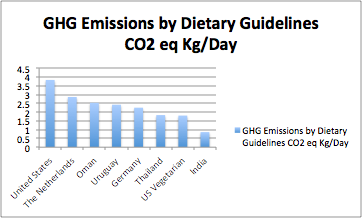Dietary Guidelines From Around the World and Their Greenhouse Gas Emissions
Plus San Diego's Desalination, Greenlands Glaciers, San Francisco Adapts to Sea Level Rise, Sanctions to Protect the Endangered Vaquita
Dietary Guidelines and Greenhouse Gases
A group of U.S. based researchers studied the dietary guidelines of the United States and six other countries. They examined the greenhouse gas (GHG) emissions resulting from residents eating diets that adhere to each nation’s guidelines. The group’s findings were published in the March 2021 issue of Nutrition Journal.
We all know that using electricity, driving our cars, and other such things throw greenhouse gases up in the air. But agriculture and food production produce GHG as well. Growing our food, harvesting, transporting, refrigerating, and cooking, all contribute up to 29 percent of global GHG.
The largest share of food systems’ GHG emissions comes from agriculture. When farmers use natural and synthetic fertilizer or certain methods of irrigation, croplands can emit nitrous oxide, a GHG that can contribute to global warming at 300 times that of carbon dioxide.

Cows produce methane in their ruminant stomachs, which they belch out. A molecule of methane warms the planet 24 times more than a molecule of carbon dioxide. Manure also produces GHG.
Not only cows, but all animals raised for food make more GHG than fruits, vegetables, and grains. Think of it: every fiber of bodily tissue that a farm animal makes results from consuming other food. So all of the GHG produced by growing corn, oats, or anything else that a farm animal eats becomes aggregated when an animal eats those crops.
Of global agricultural GHG, about half of it is produced by livestock. So how much meat is suggested in a guideline makes a big difference in that guideline’s carbon footprint. And, as the researchers point out, the global population is expected to reach 9.8 billion by 2050. In addition to more people, a growing percentage of those people are switching from diets based mostly on vegetables, beans, and grains, to something like the American diet, with its emphasis on meats. Thus, it is urgent that international governments adopt dietary guidelines promoting a smaller carbon footprint.
For the most part, governments do not consider climate change when they make their dietary guidelines. Almost 100 countries have developed dietary guidelines. Yet a recent study, looking at 83 of those countries, found that only four addressed sustainability in their guidelines, for example, by recommending that people eat more plants and less meat. A few countries have dealt with sustainability and diet in (less official) guidelines or other government agencies.
There are studies indicating that in Australia and many European countries, their national GHG emissions would go down if folks who lived there adopted their country’s dietary guidelines and moved away from what they normally eat, which is a diet that contains more meat than what the guidelines recommend.
National governments can influence the behaviors of their residents in many ways. In the U.S., as well as other countries, the federal government has had great success in reducing smoking by making and broadcasting anti-smoking ads. Other public safety and health ads have had success with automobile safety. Hence, governments could succeed if they were to promote diets that are both healthful and sustainable.
The researchers evaluated dietary guidelines in Germany, the Netherlands, Uruguay, Oman, Thailand, and India, as well as the U.S. There are some gaps in the data. For example, coffee and tea, although GHG are produced in their harvesting and transport, were not considered, because they are noncaloric parts of a diet.
Caloric intake varied from country to country. The Netherlands caloric intake recommendation is 2053 and Uruguay recommends 2200. To standardize the data, the researchers scaled all of the guidelines to 2000 calories a day. If the food quantities were given in ranges, the researchers took the midpoint of those ranges.
Most guidelines did not specify what should be eaten within each food group. For example, Thailand recommends 135 grams per day of protein-rich foods but does not specify pork, chicken, or beef. These foods differ in their GHG production. So the scientists relied on existing statistics of actual food consumption to gauge the amount of beef or pork or whatever. If a Thai’s protein intake was 50 percent chicken, 30 percent pork, and 20 percent beef, that was the mix they used in estimating the GHG of the meat intake of the Thai guidelines.
There was a great deal of variation. Protein recommendation went from 75 grams a day for India to more than twice that for the U.S. Oman recommends 168 grams per day, although more than half of that comes from vegetable sources.
The scientists found big differences in the carbon footprint of the recommended diets, from India, with 0.86 kilograms of CO2 or its equivalent per day (eq/d) to 3.83 CO2-eq/d for the United States, which is four and a half times as much. It is important to note how much meat consumption contributes to GHG. The Indian guidelines are vegetarian, and the standard U.S. guidelines include meat. Of note, the carbon footprint for the U.S. vegetarian guidelines is less than half that of the standard guidelines.
Four of the countries, The Netherlands, Oman, Germany, and Uruguay, occupy a middle ground of the range, with emissions of 2.86, 2.53, 242, and 2.25 CO2-eq/d respectively. These emissions reflect diets that have meat, but a lesser amount than that recommended in the U.S.
What is most striking to me is the great disparity of the regular U.S. guidelines and the vegetarian U.S. guidelines. At 1.8 CO2-eq/d, the vegetarian U.S. diet contributes less than half the GHG that the standard U.S. guidelines. As striking still, the vegetarian guidelines of the U.S. emit twice that of the guidelines for India.
New Voices
Our monthly Op-Ed comes to us this week from George Liddle, an environmental specialist who lives in San Diego County
Greetings from San Diego
Hi, Orange County. We hear your water agency is considering desalination. You know, we’re not so different, you and us. We signed a deal with Poseidon a few years ago. A look at how our deal is going might be interesting.
The Connecticut-based Poseidon Resources Corporation built the largest water desalination plant in the county in Carlsbad, in northern San Diego County.
The first thing to understand is that the proposal is not actually about desalination. This isn’t a decision about whether or not to build a desalination plant. The question is whether Orange County’s water agency should sign a contract with a private company that obligates the agency (and therefore you, the ratepayers) to reimburse their costs to construct the desalination plant, plus a guaranteed profit for them. That’s a pretty sweet deal for the private company, to add a bit to every water bill in Orange County for the next several decades, just for themselves. They say a good deal leaves everyone a little upset. If one party isn’t upset at all, perhaps the other party ought to be more so.
Only once the matter of paying back the company for the costs of the plant plus profits is settled, does the question then turn to water and whether you want any. I’m sure you’ve heard that the water will be expensive. This is true, which is why many other cities that have signed similar deals have elected not to buy any water from their plants. Depending on the final terms, OCWD may or may not obligate their ratepayers to buy some amount of this expensive water. But the private company has already locked in substantial profits in this deal just by building the plant, so any terms regarding purchasing water are just gravy. San Diego is still buying some water from our plant. Here’s how that is going.
In San Diego, our County Water Authority (SDCWA) is made up of 24 member retail agencies. In 2012, despite concerns from many corners over the proposal, the SDCWA agreed to a decades-long payback of costs and profits to Poseidon from a plant that had not yet been built. In December 2015, the plant opened. Just two months after the start of operations, over half a billion gallons of drinking water, including the extremely pricey desalinated water, was dumped into a reservoir where it was mixed with untreated water not suitable for drinking. So, we paid the high price for ocean water to be treated to drinking water standards, then we paid to pump it 50 miles away into a reservoir where it was subjected to evaporation and where it had to be re-treated to drinking water standards. I’d suggest you ask your policymakers if a similar outcome is possible for your proposed plant, but since our policymakers swore up and down it could never happen here, until it promptly did after just two months, some skepticism is in order.
San Diego now pays among the highest rates for water in the country. While numerous factors are surely at work, the very high cost of desalinated ocean water undoubtedly contributes to the issue. In fact, rates are so high now that two of the member agencies of the SDCWA are seeking to separate from the authority, and planning to buy water at a significantly lower cost from Riverside County. The deal we signed with Poseidon forces us to buy their expensive water, even when cheaper water is available from other sources. One wonders where these concerns over costs were on the day their representatives voted in support of a guaranteed-profit deal for pricey desalinated water. Apparently, it was only after the naysayers were ignored and the deal was signed and the plant was built and the water bills started coming in that customers took notice and put pressure on their retail water agencies. Sadly, those folks are a bit late to the party. The time to make your opinion known is before your water provider inks a 30-year contract with the priciest water supplier in town.
Our deal in San Diego gave us a beachfront eyesore, locked us in to higher rates to provide profits to a private company for many years to come, obligated us to buy expensive water whether we need it or not, and helped trigger a divorce in our local water agency. And we’re only a few years in!
Much credit to Ry Rivard (@ryrivard), whose reporting for Voice of San Diego (https://www.voiceofsandiego.org/) on this topic has been excellent.
An environmental scientist and technical writer, George Liddle specializes in environmental investigation and remediation, focusing on contaminated soil and groundwater, as well as stormwater projects.
Other News
Warming Seas Accelerate Glacial Retreat in Greenland
It turns out that the larger the glacier, the faster it melts. (NASA)
San Francisco Takes a Green Approach to Sea Level Rise Adaptation
The plans for the City By the Bay include expanding wetlands to buffer against rising seas. (NASA)
Conservation Groups Urge the U.S. and International Organizations to Sanction Mexico Over the Vaquita
As the number of vaquita, a small, beautiful porpoise whose natural habitat is the Gulf of California, has been reduced to a mere 10 individuals, a coalition of environmental organizations including the Animal Welfare Institute, the Center For Biological Diversity, the National Resources Defense Council, and the Environmental Investigation Agency is urging the U.S. as well as the Convention on International Trade in Endangered Species (CITES) to heavily sanction Mexico over its disregard for the endangered mammal.
Mexico continues to allow or look the other way when fishermen use gillnets that for decades have entangled and drowned the vaquita. The coalition urges sanctions until the use of gillnets is stopped. They are also urging the UNESCO World Heritage Committee to maintain the vaquita habitat as well as require the Mexican government to submit a management plan for the porpoise. (Center For Biological Diversity)





